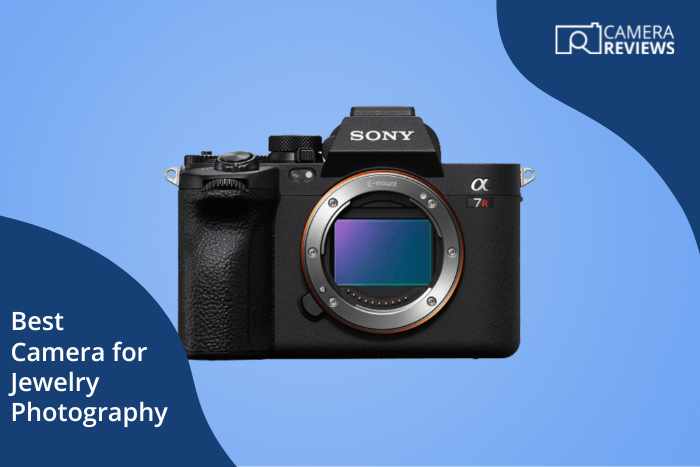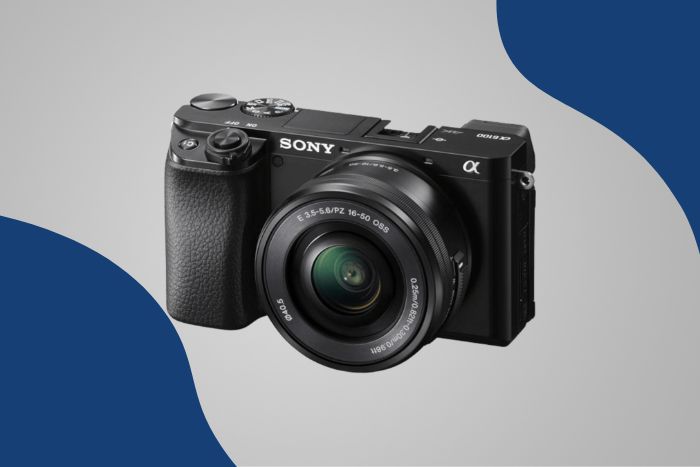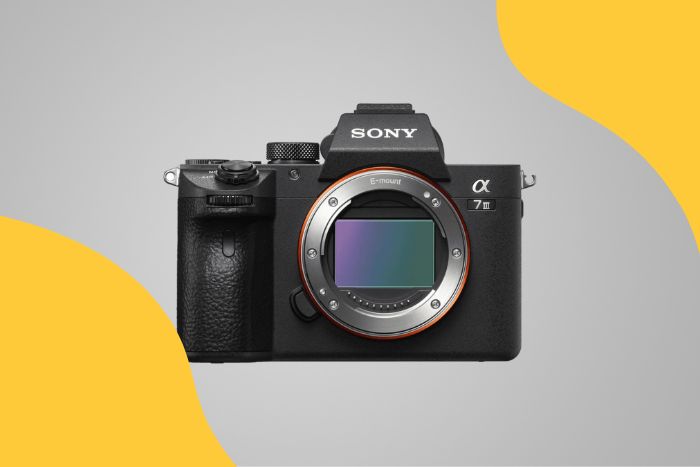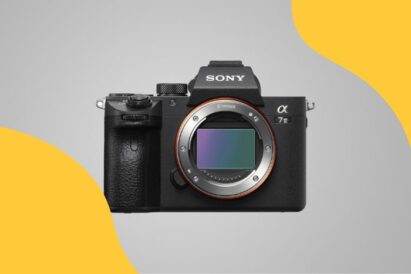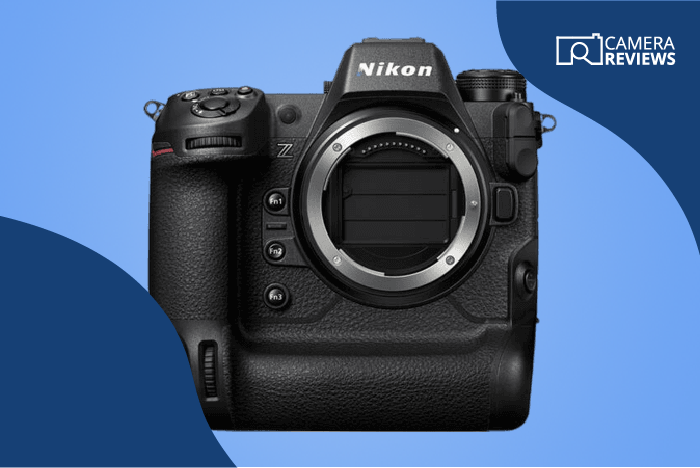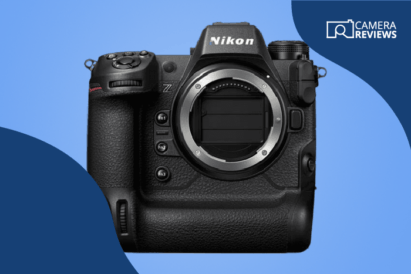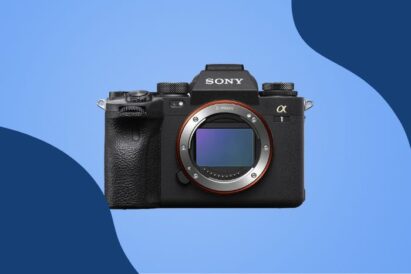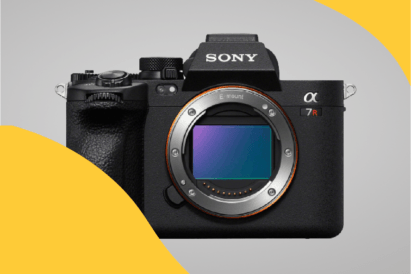When choosing the best camera for jewelry photography, you must consider some popular features more than others. Sensor size and resolution are important for any type of product photography. Frame rate, buffer size, low-light performance, or autofocus? Not so much.
This is also a photography genre where mirrorless cameras have less advantage over DSLRs. Yes, it’s nice to have a “what you see is what you get” viewfinder to check the exposure and white balance. But it’s not as important if you’re shooting tethered to your computer or tablet.
Other factors also come into play, such as connectivity and access to a wide range of macro and tilt-shift lenses. But it’s taking Canon and Nikon time to offer a complete range of lenses for mirrorless cameras. So a Canon or Nikon DSLR might be better for jewelry photography.
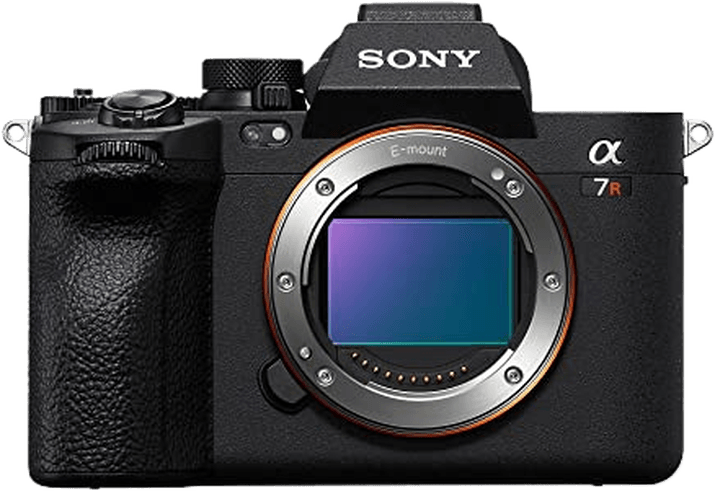
Sony a7R V
What Is the Best Camera for Jewelry Photography?
Here’s a quick summary of the best cameras for jewelry photography. The flagship products of each camera brand are just not worth the money for jewelry photography. But I’ve tried to include a selection of full frame and APS-C models suitable for all budgets!
I’ve sorted the list roughly by sensor size and resolution, which are the most important factors. And they’re all capable of tethered shooting if you prefer that.
Mirrorless models have the advantage of WYSIWYG viewfinders (This stands for ‘what you see is what you get’). And they provide an excellent upgrade path. But I’ve included a few DSLRs for those who prefer the optical viewfinder or the ergonomics.
It depends on what you already have in your camera bag and whether you need a new camera for more than just jewelry photos. If you want to know more about photographing jewelry or which camera to buy, read the FAQs at the end of this article.

- High-resolution sensor
- Automatic bird or animal eye detection
- Autofocus can track cars, trains, airplanes, and insects
- Big, bright, clear, and sharp electronic viewfinder
- 3.2-inch tilt, flip LCD screen
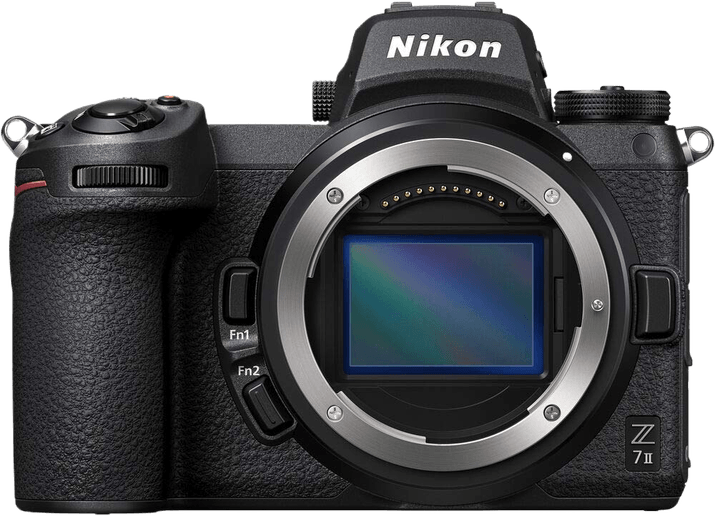
- High-resolution image sensor
- Rapid 1/8000 s shutter speed
- Excellent AF system
- Dual memory card slots
- Great 4K video at 60 fps
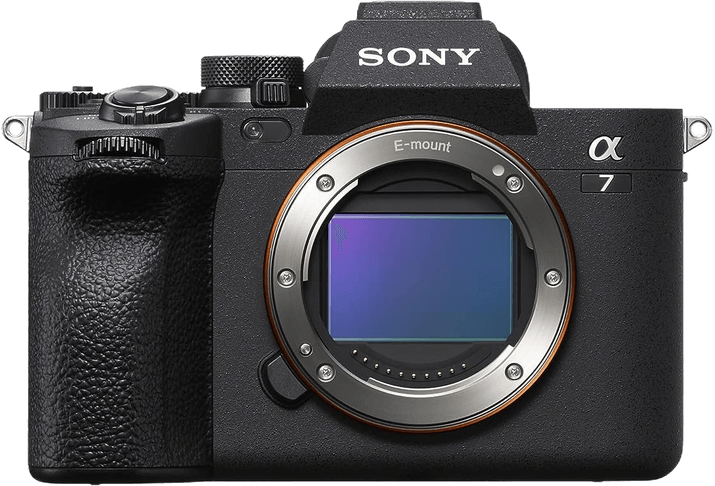
- Excellent image quality
- Super responsive autofocus
- 5.5 stops of image stabilization
- Fully articulating rear screen
- Powerful video capabilities (4K / 60p, 10-bit video) and live streaming
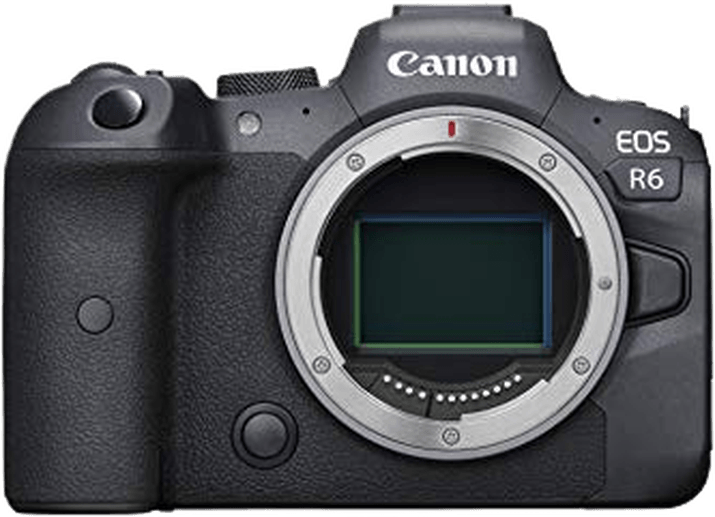
- Relatively affordable
- Excellent in-body image stabilization
- Compact and ergonomic design
- Fantastic expandable ISO range
- Rapid burst speeds
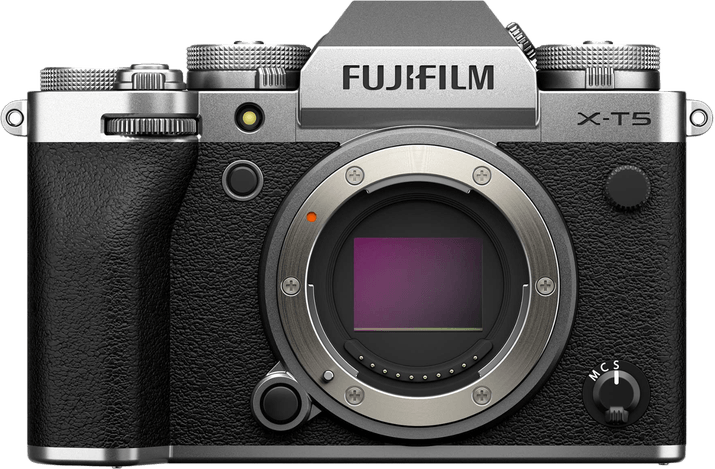
- Incredible 40.2 MP resolution from an APS-C sensor
- AF uses AI to identify and track moving subjects
- Built-in 5-axis image stabilization
- Pixel Shift Multi-Shot mode for ultra high-resolution photos
- Long-lasting, 680-shot battery
- Outstanding 6.2K video recording

- Excellent autofocus system
- Excellent ISO range
- Ergonomic camera body
- Responsive and articulating touchscreen
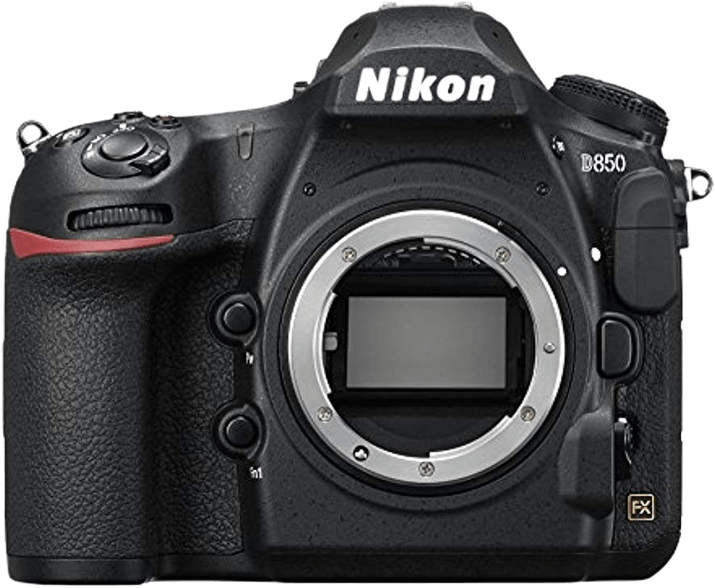
- Fantastic overall image quality
- Excellent 3D continuous AF tracking
- Long, 1,840-shot battery life
- Durable, weather-sealed construction
- Sharp 4K/30p Ultra HD video
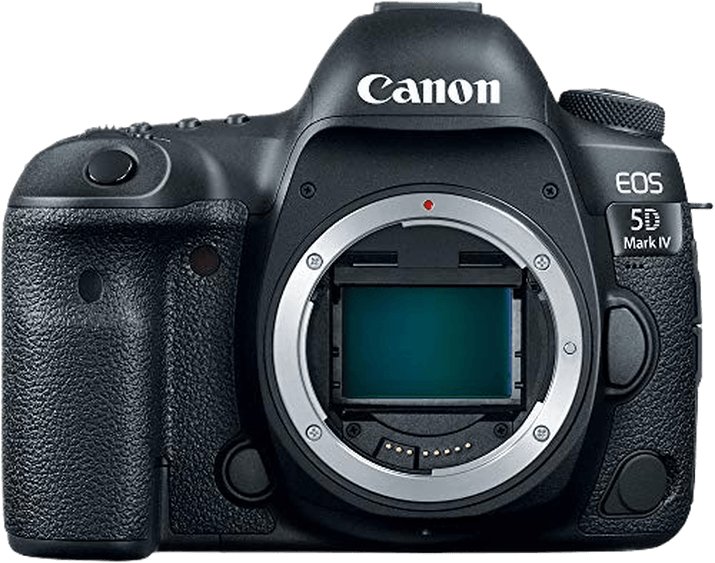
- Quality sensor produces detailed and vibrant images even at high ISOs
- Dual Pixel AF with eye detection
- User-friendly touch-to-focus screen
- 900-shot battery life
- Cinema-quality (DCI) 4K video
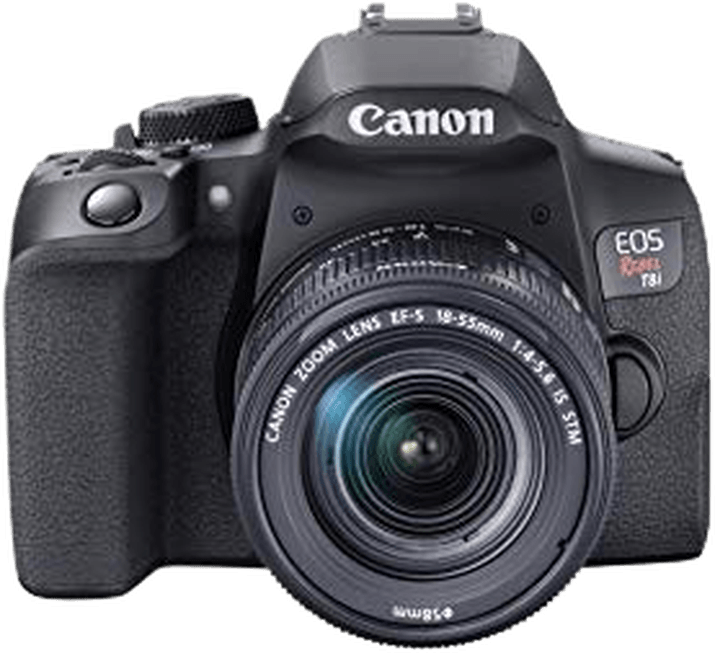
- Excellent image quality
- Face and eye-detection AF
- Great ISO range and low-light performance
- 4K/25p and Full HD/120p video
- Webcam functionality and remote shooting with smartphone
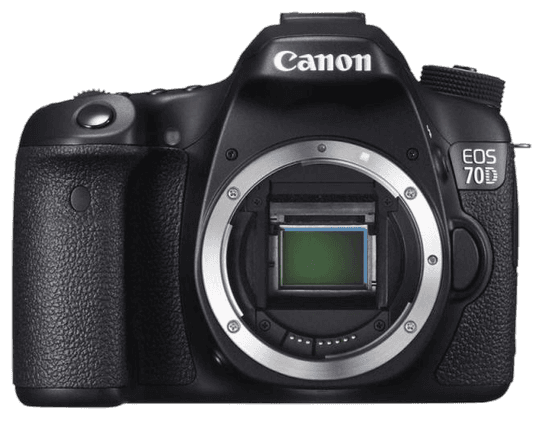
- Silent shutter mode
- Touch tracking
- Creative filters
- Touchscreen
- Built-in Wi-Fi
Best Camera for Jewelry Photography in Detail
Now let’s have a more detailed look at each camera.
1. Sony a7R V

| Camera Type |
Camera Type
|
| Megapixels |
Megapixels
61 MP |
| Sensor Format |
Sensor Format
|
| Sensor Size |
Sensor Size
35.7 x 23.8 mm
|
| Frame Rate |
Frame Rate
10 fps |
| Autofocus Points |
Autofocus Points
693 |
- High-resolution sensor
- Automatic bird or animal eye detection
- Autofocus can track cars, trains, airplanes, and insects
- Big, bright, clear, and sharp electronic viewfinder
- 3.2-inch tilt, flip LCD screen
- Slow frame rate of only 10 fps
- Focus stacking can't be done in-camera
- No in-camera RAW processing
- May be unbalanced with a big lens
- Rolling shutter effect with 8K video
The Sony a7R V is a 60 MP full frame mirrorless camera. That makes it by far the stand-out camera for jewelry photography. The resolution is the highest outside medium format cameras. And the camera’s dynamic range is excellent.
There’s a multi-shot pixel-shift high-res mode with motion correction to improve the resolution. And you also get multi-user Wi-Fi and a typically enormous range of customization options. These are useful in speeding up your workflow.
Sony has also been producing full frame mirrorless cameras longer than anyone else. That means its range of available lenses is much broader than Canon or Nikon (You can check out our Canon vs Sony or Sony vs Nikon mirrorless articles for more detail!).
There are Improvements in battery life, in-body image stabilization (IBIS), autofocus (AF), frame rate, and video. But they aren’t imperative for a great jewelry photography camera. Its focus bracketing is handy, though—even though you must combine the images on the computer.
If you want to use this camera for other kinds of photography, the only issues are rolling shutter and the lack of RAW processing. But it offers a vari-angle LCD, 8K video, and the latest AF technology.
I have a pair of Sony a1s, and even I feel a bit envious! The a7R V is not a complete all-rounder like the Sony a1. But you get all the features you need for jewelry photography at half the price!
If you’re considering buying this camera, checking some of these comparisons first:
- Canon R5 vs Sony a7R V
- Canon R5 C vs Sony a7R V
- Sony a7 IV vs Sony a7R V
- Sony a7S III vs Sony a7R V
- Fujifilm X-T5 vs Sony a7R V
2. Nikon Z7 II

| Camera Type |
Camera Type
|
| Megapixels |
Megapixels
45.75 MP |
| Sensor Format |
Sensor Format
|
| Sensor Size |
Sensor Size
23.9 x 35.9 mm
|
| Frame Rate |
Frame Rate
10 fps |
| Autofocus Points |
Autofocus Points
439 |
- High-resolution image sensor
- Rapid 1/8000 s shutter speed
- Excellent AF system
- Dual memory card slots
- Great 4K video at 60 fps
- Disappointing battery life of 420 shots
- Tilt screen has limited flexibility
- Limited lens range
- Slow frame rate of 10 fps in continuous shooting speed
The Nikon Z7 II is a 45.7 MP mirrorless camera that sits just below the all-conquering Z9. It has a higher resolution than the Z6 II. And the low native ISO of 64 improves image quality and dynamic range. These specs are important for jewelry photography, especially when shooting precious sparkling stones!
It has five-axis image stabilization, good battery life, a frame rate of 10 fps (frames per second), and 4K video. They aren’t very useful for shooting jewelry. But they’re nice extras to have. And I like the optional vertical battery grip, the comfy ergonomics, and the twin slots for SD, XQD, and CFexpress Type B memory cards.
Problems include the lack of a vari-angle LCD, the low-res electronic viewfinder (EVF), and the need for an external recorder for video. Eye AF also tends to front-focus slightly. And the autofocus system doesn’t track a given spot very well.
3. Sony a7 IV

| Camera Type |
Camera Type
|
| Megapixels |
Megapixels
33 MP |
| Sensor Format |
Sensor Format
|
| Sensor Size |
Sensor Size
23.8 x 35.6 mm
|
| Frame Rate |
Frame Rate
10 fps |
| Autofocus Points |
Autofocus Points
759 |
- Excellent image quality
- Super responsive autofocus
- 5.5 stops of image stabilization
- Fully articulating rear screen
- Powerful video capabilities (4K / 60p, 10-bit video) and live streaming
- More expensive than the Sony a7 III
- 6 fps with 14-bit lossless compressed or uncompressed RAW files
- Significant distortion with moving subjects using a silent shutter
- Occasional issues with rolling shutter
- Requires a fast memory card
The Sony a7 IV is a 33 MP full frame mirrorless camera with excellent image quality and dynamic range. It has a simple, reliable autofocus system, a 10 fps burst rate, and many custom options.
The ergonomics are better than the older a7s. There are two slots for SD or CFexpress Type-A cards. And you get USB-PD support for fast charging or remote control. It also comes with a better interface and AF system than previous versions.
The a7 IV offers excellent options for recording video. It provides full-width oversampled video (4K from 7K up to 30 fps). And there is 4K from 4.6K capture at 60 fps in Super35 or APS-C mode.
There’s also the option of 10-bit video for full HLG (Hybrid Log Gamma) capture on HDR TVs. And there is HEIF still capture for high-quality, small-compression files. Plus, you can use cinematic S-Cinetone color mode or shoot in highly efficient H.265 video.
The only problems are the slightly jerky stabilization and the Catalyst Browse Software. In exchange for a bigger crop, this lets you add stabilization using the gyro sensor readings. But it’s a pain!
4. Canon EOS R6 Mark II

| Camera Type |
Camera Type
|
| Megapixels |
Megapixels
24 MP |
| Sensor Format |
Sensor Format
|
| Sensor Size |
Sensor Size
24 x 36 mm
|
| Frame Rate |
Frame Rate
40 fps |
| Autofocus Points |
Autofocus Points
4,897 |
- Excellent dynamic range and low-light performance
- Advanced autofocus with object-detection
- High-speed 40-fps burst mode
- Built-in image and video stabilization
- Ultra-smooth 4K/60p video and webcam functionality
- 24.2 MP resolution low for full-frame mirrorless
- Not many big improvements from the EOS R6 Mark I
- Disappointing 360-shot battery life
- Camera body can get hot when using advanced features
The Canon EOS R6 Mark II is a 24 MP full frame mirrorless camera. Like the Sony a7R V and Nikon Z7 II, it sits just below the flagship model. That means it offers better value for money without compromising the features you need for jewelry photography.
The resolution is slightly lower than the other cameras we’ve seen. But it’s enough for studio shots, as you shouldn’t need to crop them later.
The smaller file sizes mean you only need SD cards rather than the more expensive XQD or CFexpress Type-B cards. Using Adobe Lightroom or Capture One, you also get a 10 Gbps USB-C port for fast data transfer and tethering.
This model also offers good ergonomics, focus bracketing, and an articulated touchscreen. And you can also customize the Q menu to rapidly access the most common camera settings.
But some features are not as relevant to jewelry photography. These include AF tracking, a 12-bit RAW frame rate of 40 fps (with pre-buffering), an eight-stop IBIS system, a 580-shot battery life, and 6K video. But they’re nice if you use the camera for other photography.
On the downside, the RAW files have built-in noise reduction and a few menu mistakes. And there are also problems when shooting videos:
- The AF is not as good
- The IBIS wobbles with wide-angle lenses
- You can’t see the histogram and lens gauges when recording
There aren’t many Canon RF lenses, and the company limits third-party products. But you can always get the RF 100mm f/2.8L Macro IS USM. This is a pro macro lens with 1.4x magnification and Spherical Aberration Control to manage bokeh.
And there aren’t any tilt-shift options. But the TS-R 14mm f/4L and TS-R 24mm f/3.5L are coming soon.
5. Fujifilm X-T5

| Camera Type |
Camera Type
|
| Megapixels |
Megapixels
40 MP |
| Sensor Format |
Sensor Format
|
| Sensor Size |
Sensor Size
15.6 x 23.5 mm
|
| Frame Rate |
Frame Rate
15 fps |
| Autofocus Points |
Autofocus Points
425 |
- Incredible 40.2 MP resolution from an APS-C sensor
- AF uses AI to identify and track moving subjects
- Built-in 5-axis image stabilization
- Pixel Shift Multi-Shot mode for ultra high-resolution photos
- Long-lasting, 680-shot battery
- Outstanding 6.2K video recording
- 40.2 MP resolution creates large files for storage
- Lowest ISO is 125, not 100
- Limited RAW buffer for full-resolution burst shooting
- Rolling-shutter effect is sometimes visible with video
- Video has a 1.23x crop factor at full resolution
The Fujifilm X-T5 is a 40 MP APS-C mirrorless model with “hipster” film camera looks. It sits below the flagship X-H2. But the missing features aren’t worth the extra $300 if you don’t shoot much video!
Although it has an APS-C sensor, the resolution is more than enough to capture enough detail. There’s even a 20-shot, 160 MP high-resolution mode.
You also get a few “nice-to-have” features. These include a 15 fps burst rate, eye detection and tracking, 7.0 stops of IBIS, various film simulations, Bluetooth, and Wi-Fi. And you get 6.2K / 30p or subsampled 4K / 60p video footage with various 10-bit options.
On the downside, there’s no touchscreen menu or battery grip. And eye tracking is unreliable. It also lacks the flip-out vari-angle rear screen from the X-H camera line.
6. Canon EOS R

| Camera Type |
Camera Type
|
| Megapixels |
Megapixels
30.3 MP |
| Sensor Format |
Sensor Format
|
| Sensor Size |
Sensor Size
24 x 36 mm
|
| Frame Rate |
Frame Rate
8 fps |
| Autofocus Points |
Autofocus Points
5,655 |
- Excellent autofocus system
- Excellent ISO range
- Ergonomic camera body
- Responsive and articulating touchscreen
- No in-body image stabilization
- 4K video is cropped
- No dual SD card slot
- Limited battery life compared to DSLR
The Canon EOS R is a budget 30 MP full frame mirrorless camera. It has more megapixels but slightly fewer impressive features than the EOS R6 Mark II. And it comes at a much lower price!
The expanded ISO range drops by half, the burst rate falls to 8 fps (with no pre-shooting buffer), the battery life is shorter, and the video is limited. You don’t get focus bracketing or animal or vehicle tracking either. And there are delays when reviewing images.
But you get more focus points, and the LCD is larger with a higher resolution. It’s also slightly lighter with weather sealing. And you get an LCD screen on the top plate.
There are multiple options for customizing the controls and the multi-function bar. And the EOS R also has three optional adapters that let you fit any EF or EF-S (full frame or APS-C) lens.
7. Nikon D850

| Camera Type |
Camera Type
|
| Megapixels |
Megapixels
45.7 MP |
| Sensor Format |
Sensor Format
|
| Sensor Size |
Sensor Size
23.9 x 35.9 mm
|
| Frame Rate |
Frame Rate
7 fps |
| Autofocus Points |
Autofocus Points
153 |
- Fantastic overall image quality
- Excellent 3D continuous AF tracking
- Long, 1,840-shot battery life
- Durable, weather-sealed construction
- Sharp 4K/30p Ultra HD video
- No customizable shooting presets
- Slow autofocus in Live View
- Needs an expensive XQD card
- Rolling shutter noticeable in 4K video
- Slow 7 fps or 9 fps with an expensive battery grip
The Nikon D850 is a 45.7 MP full frame DSLR. I used to own one but traded it for a pair of Sony a1 mirrorless cameras. I’d have kept it if I was taking photos of jewelry rather than wildlife.
The main reasons I got rid of it were the low frame rate of 7 fps and the lack of eye detection. But neither is a deal-breaker if you only want to photograph jewelry.
It’s also a bit of a brick. But that doesn’t matter either if you use a tripod. Otherwise, it does exactly what you need it to do. And if you use the optical viewfinder, it offers high resolution (with no AA filter), great autofocus, and a high dynamic range.
You also get weather-sealing, illuminated buttons, long battery life, an easy interface, and slots for XQD and SD cards. Plus, built-in Wi-Fi, NFC, and Bluetooth connectivity make file-sharing easy.
The tilting touchscreen isn’t perfect, but it’s better than a fixed screen. And you can shoot 4K video. You can also add a battery grip for over 5,100 shots and easy switching between portrait and landscape.
But there is a list of minor issues:
- Live View autofocus is only contrast detection, making it slow for both stills and video.
- Subject tracking is not as good as on the Nikon D5.
- XQD cards are faster than their SD equivalents but are much more expensive.
- The SnapBridge software isn’t very user-friendly or sophisticated.
- Lenses must be calibrated properly—as I learned when shooting polar bears on Svalbard!
- The rolling shutter is obvious in 4K video.
- Focus peaking isn’t available when shooting 4K.
If you’re interested in knowing more, check out my full Nikon D850 review or our Nikon D780 vs D850 comparison!
8. Canon EOS 5D Mark IV

| Camera Type |
Camera Type
|
| Megapixels |
Megapixels
30.4 MP |
| Sensor Format |
Sensor Format
|
| Sensor Size |
Sensor Size
24 x 36 mm
|
| Frame Rate |
Frame Rate
7 fps |
| Autofocus Points |
Autofocus Points
61 |
- Quality sensor produces detailed and vibrant images even at high ISOs
- Dual Pixel AF with eye detection
- User-friendly touch-to-focus screen
- 900-shot battery life
- Cinema-quality (DCI) 4K video
- Unreliable, imprecise subject tracking
- Limited dynamic range
- No in-body stabilization
- No bluetooth
- 64x crop factor with 4K video
The Canon EOS 5D Mark IV is a compact, 30.4 MP full frame DSLR camera aimed at enthusiasts. The sensor resolution is only half that of the a7R V, but it’s still plenty for close-up work.
Plus, people rave about “Canon color.” And the noise performance is also good.
One nifty camera feature for jewelry photography is its Dual Pixel RAW photo processing. This works by taking two 30 MP images from the “right-looking” and “left-looking” photodiodes on each pixel.
The resulting file is twice as large. But you can use Canon’s Digital Photo Professional software. It can shift bokeh, reduce ghosting, and make micro-adjustments.
The Dual Pixel AF system is excellent. But it only works in Live View or when shooting video. With the optical viewfinder, the camera uses a 61-point AF system (41 cross-type). This has up to 24% more vertical coverage than the EOS 5D Mark III.
Other improvements include AF precision and speed, dynamic range, and resolution. And the Wi-Fi with NFC connectivity, touchscreen, and weather sealing are all typical of Canon cameras.
You also get various features suitable for other types of photography. These include a burst rate of 7 fps, face detection and tracking, GPS, and DCI 4K video at 30 or 24 fps (with frame grabs).
But 4K video has a 1.64x crop, you get rolling shutter, and intelligent tracking-and-recognition (iTR) is poor. And you can’t link spot metering to the active focus point.
Plus, Motion JPEG is the only file format for video, and you don’t get Log gamma, focus peaking, zebras, or a 4K HDMI output. And finally, the fixed rear LCD is a bit inconvenient.
9. Canon EOS Rebel T8i

| Camera Type |
Camera Type
|
| Megapixels |
Megapixels
24 MP |
| Sensor Format |
Sensor Format
|
| Sensor Size |
Sensor Size
14.9 x 22.3 mm
|
| Frame Rate |
Frame Rate
7.5 fps |
| Autofocus Points |
Autofocus Points
45 |
- Excellent image quality
- Face and eye-detection AF
- Great ISO range and low-light performance
- 4K/25p and Full HD/120p video
- Webcam functionality and remote shooting with smartphone
- Fiddly control dials
- Less reliable AF in video mode
- Small optical viewfinder display
- Cropped 4K video
The Canon EOS Rebel T8i is a compact and affordable 24 MP APS-C “high entry-level” DSLR camera. (It’s also known as the EOS 850D or EOS Kiss X10i.)
It has a handy, fully articulated touchscreen. And like the EOS 5D Mark IV, it offers a 7 fps burst rate with face and eye detection using Dual Pixel AF in Live View or while shooting video. Otherwise, the 45-point all-cross-type AF system takes over.
The T8i offers comfortable ergonomics, good battery life, and 4K / 24p video. Vloggers can shoot vertical videos. And there’s a 3.5mm input for an external microphone.
But 4K video has a 1.6x crop, Full HD can show moiré and false color, and there are fewer focus points than mirrorless cameras. There’s also no IBIS or USB charging. And the optical viewfinder gives only a small, dim view of the world outside.
Any EF or EF-S lens can be used. But there are only 14 cheaper EF-S lenses (including two macros). And the EF lenses are bigger and dearer. And with DSLR cameras on their way out, this is unlikely to change.
10. Canon EOS 70D

| Camera Type |
Camera Type
|
| Megapixels |
Megapixels
20.2 MP |
| Sensor Format |
Sensor Format
|
| Sensor Size |
Sensor Size
15 x 22.5 mm
|
| Frame Rate |
Frame Rate
7 fps |
| Autofocus Points |
Autofocus Points
19 |
- Silent shutter mode
- Touch tracking
- Creative filters
- Touchscreen
- Built-in Wi-Fi
- Only one SD card slot
- No 4K video
- LCD blacks out in burst in live view
- No subject tracking in burst mode
- Electronic level doesn't show pitch
The Canon EOS 70D is a 20.2 MP mid-range APS-C DSLR camera for enthusiasts. And it’s the most affordable Canon DSLR on our list.
Like the other Canon cameras, it has Auto Lighting Optimizer and Highlight Tone Priority. They keep detail in shadows and highlights, which is handy when shooting jewelry.
It also uses Dual Pixel AF in Live View and while shooting video. Otherwise, it has a 19-point all-cross-type AF system borrowed from the 7D.
The camera also offers a 7 fps frame rate, silent shutter mode, touch tracking, and Creative Filters. Finally, you get a touchscreen, built-in Wi-Fi, and a smartphone remote control.
Sadly, there’s only one SD card slot. The best video is only 1080p at 30 fps. The electronic level only shows pitch and roll. High Dynamic Range and Multiple Exposure modes only work with JPEGs. And the smartphone app can’t share full-size files.
During continuous shooting, the LCD blacks out in Live View, and you can’t use subject tracking. The Wi-Fi setup is complex, and movie mode is disabled once done. HDR mode is unavailable with RAW files. And the battery life in Live View is disappointing.
Our Verdict
The best camera for jewelry photography needs a high-res sensor. And it’s best if it works with a good tilt-shift or macro lens. Plus, it should have the ability to shoot tethered. That being the case, you must ask yourself if you need a flagship camera. High-end models are generally expensive—especially the Sony a1!
Jewelry photos aren’t as demanding as wildlife or sports. So you should “date your camera, but marry your glass.” The best camera for jewelry photography doesn’t need a fast frame rate, great autofocus, or 4K video.
So you might be better off with a slightly more affordable one, such as the Sony a7R V or the Nikon Z7 II. But if you prefer a DSLR camera or want to keep your lenses, pick a Nikon D850 or a Canon EOS 5D Mark IV.

Sony a7R V
Best Camera for Jewelry Photography FAQs
Here are answers to some of the most-asked question about cameras for jewelry.
Which Camera Is Best for Jewelry?
A full frame, high-resolution sensor camera is best. But other factors come into play. These include access to a compatible macro lens and the ability to shoot tethered to your computer, tablet, or smartphone.
The main criteria for a high-quality camera are usually sensor size, frame rate, and autofocus. But the frame rate doesn’t matter as you aren’t shooting moving subjects. And you’ll probably be using manual focus.
What Is the Best Way to Photograph Jewelry?
Use a tripod and a lightbox for soft, consistent lighting. And tethered shooting is a great way to get framing, exposure, and sharpness feedback. For best camera settings, shoot at base ISO with a narrow aperture for the right depth of field.
Shooting in RAW and using an 18% grey card will help you adjust the white balance. And using a polarizing filter means brighter, more saturated colors with minimal glare or reflections.
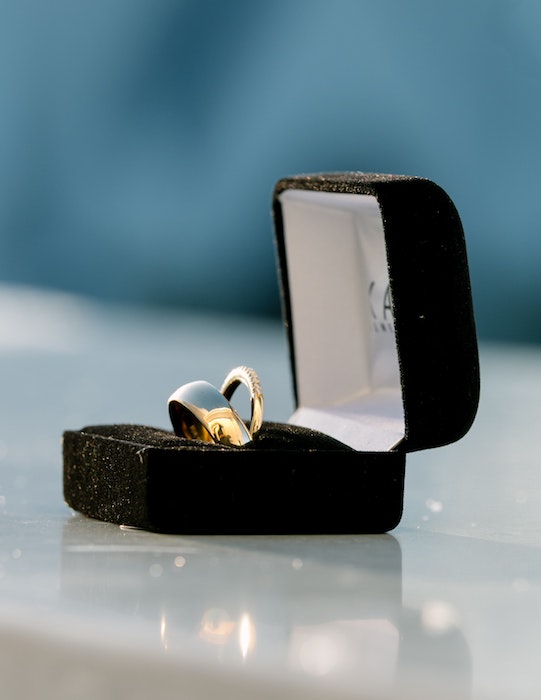
You can either focus manually or use autofocus with manual override. Plus, focus stacking is another option to keep the whole item sharp.
A white background is best. But you can also use a model, display busts, or transparent plastic wire for necklaces. Just make sure you clean and polish the items in advance. You should also take group and individual shots at different angles.
Do Jewelry Photographers Need Macro Lenses?
A macro lens is often useful for smaller items or larger-size prints. But a short zoom will also work, such as an 18-55mm—especially for online images. Macro lenses enable you to produce images at life-size (1:1). Plus, they usually have a minimum focusing distance of only a few inches.
A longer focal length, like 105mm, will give you a more magnified image at the same distance. Or it lets you shoot from slightly further away. Another alternative is a tilt-shift lens, which will give you a greater depth of field.
How Do You Take Professional Pictures of Jewelry?
Photographing jewelry professionally involves preventing unsightly reflections. For that, you need a controlled studio environment. If you shoot tethered with a tripod and lightbox, you can adjust your setup until everything’s perfect.
The light you get from a light box might be too soft to add sparkle to precious stones such as diamonds. So you might have to add a bright LED at 45 degrees. If using multiple lights, ensure the color temperatures are the same.
We hope you picked up some good tips from this article. If you’re still unsure which camera to go for, you can try our camera comparison tool or camera finder quiz next!


